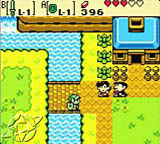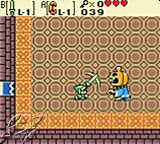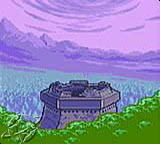 |
The Legend of Zelda: Oracle of Ages - Review |
 |
Buy something! A Shield for 50 Rupees?
By: MarioMax
| Review Breakdown |
| Battle System |
9 |
| Interface |
9 |
| Music/Sound |
8 |
| Originality |
7 |
| Plot |
5 |
| Localization |
9 |
| Replay Value |
8 |
| Visuals |
9 |
| Difficulty |
Very Hard |
| Time to Complete |
30-60 hours
|
|
| Overall |
 |
| Criteria
|
The Legend of Zelda series, one of Nintendo's flagship lines of games, has just been given not ONE, but TWO very awesome additions: The Oracle of Ages, and the Oracle of Seasons. This review is covering The Oracle of Ages, the deeper, highly puzzle-oriented version of the two. I'll go out on a limb and call this the best game to ever make the GameBoy Color its home.
Anyone that's played "Link's Awakening" or even "A Link to the Past" will feel right at home with the controls. Simple overhead hack-and-slash using the Crosspad and the A and B buttons. Your primary weapons include your Sword, bombs, and some Mystical Seeds. Secondary items include the Roc's feather (for jumping), Power Bracelet (for lifting stuff), and your trusted Shield for deflecting small rocks. When you get hit by an enemy weapon, you bounce back and take damage, which is displayed in your heart meter. Conversely, when you attack an enemy, it bounces back and flashes for a second. Keep attacking the enemy and it explodes, often leaving behind items such as Rupees (the currency), Seeds, and the occasional dungeon Key.
Controlling your character is often as simple as walking up to Point A, pressing the A button to "talk" to whatever object you come across, reading what has to be said, then moving on. Other times, it involves Running to Point A, slashing Enemy B, switching to Item C, Removing Obstacle D, then running to point E before ANOTHER Wallmaster swoops down and returns you to the beginning of the dungeon. Ah, the nostalgia...but anyway, back to the review. Pressing Start in the main adventure screen brings up a nice menu for picking out what items you want (as found in every Zelda game). Inside this menu are three sub menus you can switch to: One displays your current items you can "equip" to your A and B buttons; the next displays important items such as the Zora Flippers and the Magic Potion; the last one displays how many Pieces of Heart you've collected, how many Essences of Time you've collected, and what the present Age is (yes, this is a time travel game, but a good one!). Pressing Select brings up either an overworld map showing important landmarks that you've explored, or the present dungeon map. Both are very easy to navigate.

|
| Check out those pretty tile-based terrains!
|
|
Because this game runs on a GameBoy Color, one should not expect a fully orchestrated "One Winged Angel" or even something like a multi-instrument rendition of the Super Mario Bros. theme. However, the musical selection just can't be beat. Nintendo made excellent use of the system's limited sound abilities. Far too often I found myself partially engulfed by the game's various musical atmospheres. Other times, I found myself listening to several tunes pulled, note for note, straight from Link's Awakening. Surprisingly, I found a ton of remixed versions of music from previous Zelda games, everything from the original NES hit to Ocarina of Time. Sound effects are nothing to throw a Deku Stick at; 90% of the game's SFX are copy/pasted directly from Link's Awakening. That's not necessarily a bad thing, given the system's limited abilities. However, should there be a GameBoy Advance Zelda, I will be expecting sound effects that are of much higher quality.
As far as gameplay originality is concerned, hack-and-slash mixed with random puzzles has been done too many times. What makes this game so special is its ability to "link" with The Oracle of Seasons. Here's how it works. You beat Oracle of Ages. At the end, you're given a password. In order to use this password, you must have a free Oracle of Seasons file. You insert the password, and essentially you "continue" your Oracle of Ages quest, but in Seasons, kind of like a 2nd Quest. Throughout this 2nd Quest, you are told "secrets," which are essentially more passwords. You must in turn tell these secrets to certain people in your Ages file to unlock a hidden item or power-up that can then be transferred back into Seasons using yet MORE passwords. Sound confusing? It is, but adds immensely to the replay value.
The plot is cliché at is best: boy summoned to strange land, meets girl, evil villain captures girl, world falls into chaos, boy restores order and rescues the girl, ba da bing, ba da boom. However, the way the story are presented is top notch. The story is very complex, and may easily blow over some younger gamers, but is entertaining nonetheless. Thanks to the clever password system (see previous paragraph), the player is able to unlock far more gameplay with both games than this one by itself. In essence, it boils down to this: With just Ages, you have only one quest. Add Seasons, and you now have four different stories that can be told, two on each game pak. Only by beating one game can the true ending be unlocked in the other game. Those of us on a limited budget will be longing for, however.
Since 99% of the story is told through dialog boxes, much has to be translated to the American tongue. Fortunately, this will not disappoint. I hardly found a single badly-translated piece of dialog, and most of the story actually makes sense! Granted, Nintendo could've done a bit better job explaining the password system, but I won't hold it against them.

|
| Every kid's nightmare at Halloween |
|
Will you play this game? Absolutely. This is Zelda we're talking about. You always discover something new when playing Zelda games, be it that Bomb upgrade or that missing Piece of heart. Will you play it over and over and over? Probably not, unless you also have Seasons. Without it, Oracle of Ages falls flat in the replay department (kinda like most RPGs).
Visually, this game is one of the best looking 2-D Zelda games I've ever seen, even on a portable. Granted, we're dealing with a system that can only use 3-color sprites and 56 maximum on-screen colors, but that doesn't stop the eye candy! Everywhere you go, you see a wide variety of bright colors on the overworld, down to earth colors in caves and houses, and dark and moody colors in the many dungeons. When swimming underwater, everything (even the text box) is affected by the ripple effect caused by the water, a very nice effect. The few cut-scenes this game has are also top notch, even though most consist of single-frame stills. Without a doubt one of the most visually stunning GameBoy Color games I've ever seen.
I'll be honest. Unless you're a fan of mind-boggling puzzles and complicated mazes, Oracle of Ages is not the game for you. I had to consult a walkthrough several times to clear many of the dungeons! Heaven forbid if I try playing it WITHOUT one! It's a good thing the bosses weren't hard to beat, once I figured out their weak points! As far as playing through the rest of the game, you should easily breeze through it.

|
| They must be building something, no? |
|
Unless you consult walkthroughs, Oracle of Ages will probably keep you occupied for well over 2 weeks (I played it 8 hours a day for a week before I beat the first quest. Your mileage may vary). I am, of course, ignoring the whole password system, and the 2nd Quest system. You can probably breeze through most of the 2nd Quest if you played the 1st Quest, if you still remember some of the puzzle solutions.
All in all, a very well designed Zelda game. Visually stunning, nice musical score, responsive controls, and an incredible password system are sure to keep any RPGamer busy. I definitely recommend this game. If anything, it'll give your GameBoy Color one last reason to exist before the GameBoy Advance takes over.
|










